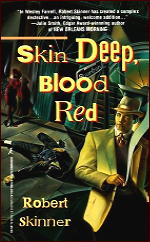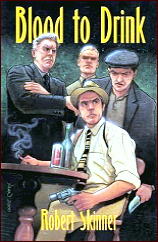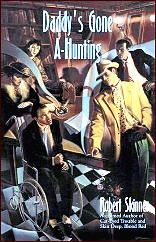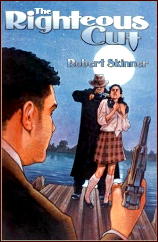Tue 17 Apr 2012
Archived Review: ROBERT SKINNER – Daddy’s Gone A-Hunting.
Posted by Steve under Bibliographies, Lists & Checklists , Characters , Reviews[5] Comments
ROBERT SKINNER – Daddy’s Gone A-Hunting. Poisoned Pen Press, hardcover, 1999; trade paperback, 2000. Hardcover reprint: Detective Book Club, 3-in-1 edition.
At the present time there are six books in Robert Skinner’s series of Wesley Farrell adventures, of which this is the third:

Cat-Eyed Trouble (Kensington, 1998)
Daddy’s Gone A-Hunting (Poisoned Pen, 1999)
Blood to Drink (Poisoned Pen, 2000)

Pale Shadow (Poisoned Pen, 2001)
The Righteous Cut (Poisoned Pen, 2002)
Wesley Farrell is a mixed-blood Creole by birth, but at the time of this book, which is 1938, he’d been living in New Orleans as a white man for over 25 years. He’s a legend of a man — a night club owner whom everyone in the city seems to know and will defer to, rather than get on the wrong side of him. Nonetheless (and inevitably) it’s strictly his reputation that gets him into trouble this time.

There are several threads of the widely rambling plot. The major one centers on the deaths or mysterious disappearances of prominent members of the aforementioned black community. Less important, or so it seems, is the request that Carol Donovan (*), the beautiful black owner of The Original Southport Club, makes of Farrell. She needs his help in fighting a tough thug named Archie Badeaux who has been making threats against her.
A stash of stolen money that has gone missing is also involved, and when Ernie LeDoux gets out of prison and starts looking for it, a brand new series of events is pushed into motion. And there’s more. It takes well over 300 pages of fine action-oriented fiction to cover it all.
Great characters and great atmosphere combine to make Gone A-Hunting very enjoyable reading. Back in 1938, and particularly in the South, there was an entire black community whose activities never made the white newspapers, and they certainly weren’t recorded in the white history books.
A separate black squad of the detectives in the police department, black bankers and real estate agents — an entirely separate (but not equal) citizenry — which you notice most when you are reminded, as Skinner does, that trains, for example, had separate cars for blacks.

Most of the threads of plot come together at the end, but not all. In all truthfulness they’re spread too thin to have the depth that would make this an absolute knockout of a novel. Sometimes the longer the book, the weaker the punch. The clues which the detection depends upon are suspect as well — what kind of witless killer would vomit at each of his scenes of the crime, and fail to clean up his mess afterward?
But there are more adventures to come, and a couple of priors to catch up with also. I came in at the middle, and now with two different ways to go, I fully intend to.
(*) PostScript: Here’s a quote that here, just now, at the last minute, I decided to leave you with. From page 21:
Maybe Halle Berry could play the part? I was leaning toward a younger Richard Roundtree as Farrell, back when he played Shaft in the movies. When I mentioned this to another reader of the series (female), she immediately reminded me that Farrell is passing for white, and Roundtree is therefore too dark.
She then suggested Giancarlo Esposito, who appears on some television show I don’t watch. I obviously have to think this over some more.
April 17th, 2012 at 5:41 pm
There were six books in the series when I wrote this review, and unfortunately there are still only six now.
The good news, sort of, is that after writing this review I had five other books waiting for me to read, and there still are five books in the series I haven’t read, or at least, not yet.
I remember enjoying this book quite a bit. I wish I’d done what I’d promised myself in the last line. On the other hand, there’s still time.
April 18th, 2012 at 8:01 am
Thanks for this positive review. I’m glad to know people are still reading my work. Hurricane Katrina kind of knocked me out of the box, but I hope to revive Farrell after I retire next year.
Best regards,
Bob Skinner
April 18th, 2012 at 10:29 am
Bob
That’s great news. Super!
— Steve
April 18th, 2012 at 9:40 am
Loved the first couple of these, and I’m very happy to learn there are four more to find and read! (And maybe more to come–thanks for the update Mr. Skinner.)
Giancarlo Esposito may be known to you, Steve, playing the Yaphet Kotto character’s prodigal FBI agent-son in some of the latter seasons of HOMICIDE: LIFE ON THE STREETS; at least that was when I became aware of him.
Additionally in the genre he was the very sinister owner of the chicken franchise, who was Walter White’s boss and nemesis in the most recent seasons of AMC’s BREAKING BAD
April 18th, 2012 at 10:38 am
Rick
I just looked through Giancarlo Esposito’s resume on IMDB. It’s a lengthy one, but here it is nine years later, and still there isn’t anything I remember seeing him in, even shows like Law & Order, Homicide: Life on the Street and Breaking Bad, none of which interested me enough to watch consistently.
— Steve